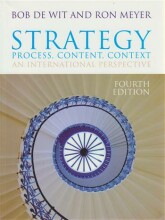Summary: Introductie
- This + 400k other summaries
- A unique study and practice tool
- Never study anything twice again
- Get the grades you hope for
- 100% sure, 100% understanding
Read the summary and the most important questions on Introductie
-
1 CONTROL & SURVEILLANCE
This is a preview. There are 2 more flashcards available for chapter 1
Show more cards here -
Four Essential Elements of Scientific Management
• Careful selection of workers
• Inducing and training the worker by the scientific method
• Equal division of work between management and workers
• Discovering the scientific method for tasks and jobs -
2 Structural Organization Theories
This is a preview. There are 10 more flashcards available for chapter 2
Show more cards here -
Contingency theory in a nutshell
• No universal or “one best way” to manage or organize
• Organizational design must ‘fit’ with the environment (both externally and internally)
• Managers can adapt their organization to fit environmental demands
• Efficient adaptation involves strategies, structures, and processes -
3 CULTURE & PARADOX
This is a preview. There are 1 more flashcards available for chapter 3
Show more cards here -
Forms of control in organizing
• Utalitarian incentives
• Forms of coercion
• Normative control (‘playing’ with
culture) -
What are the three perspectives of organization culture according to JoAnne Martin
– "Integration" ‐ all members of an organization share a
consensus of values and purpose [dominant perspective];
– "Differentiation" ‐ there are frequent conflicts among groups in
organizations with limited consensus [sub‐culture perspective];
– "Fragmentation" ‐ there is considerable ambiguity in
organizations with consensus coexisting with conflict, and much
change among groups. -
What is a paradox
Paradoxes framed as inescapable dilemmas elicit one type of reaction, while those viewed as opportunities for growth elicit another. -
4 ORGANIZATION THEORY IN USE
This is a preview. There are 2 more flashcards available for chapter 4
Show more cards here -
What are the building blocks from Whetten
1. What - Entities
2. How - relationship(s) among the entities
3. Why - the underlying dynamics that link the entities
4. Who, Where, When - the boundary conditions to the relationship -
5 POWER & DISORGANIZATION
This is a preview. There are 3 more flashcards available for chapter 5
Show more cards here -
Three forms of power
Power over … (coercion)
Power to … (empowerment, emancipation)
Power with … (negotiation) -
According to Fleming en Spicer there are four faces of power namely:
A. Episodic ( to shape behavior)
1. Coercion - Force/ dwang
2. Manipulation - zaken aanpassen zodat ze in lijn dr verwachtingen komen.
B. Systematic ( to mobilize institutional, ideological & discursive resources to influence organizational activity)
3. Domination - invloed verkregen op basis van ideologische waarden
4. Subjectification - onderwerping -
What does Foucault saying about power
Thesis about power based upon Foucault:
- Power is not about possession, power is a strategy.
- Power cannot be located but is ubiquitous (is everywhere).
- Power works through normalization.
- Power is not destructive but constructive and productive. -
6 RESOURCE DEPENDENCE & ORGANIZATIONAL ECOLOGY
This is a preview. There are 8 more flashcards available for chapter 6
Show more cards here -
What's resource dependence theory
- “To survive, organizations require resources. Typically, acquiring resources means the organization must interact with others who control the resources. In that sense, organizations depend on their environment” (Pfeffer & Salancik, 1978: 258)
- Power involves control over key resources
- External focus rather than internal
- Organizations try to minimize their dependence on other organizations for the supply of resources
- Organizations try to influence their environment to make those resources available
- Higher grades + faster learning
- Never study anything twice
- 100% sure, 100% understanding
































